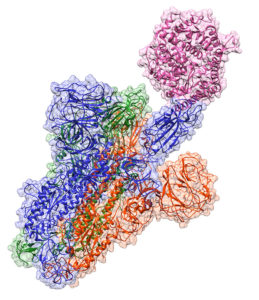If you’ve been following COVID-19 research, by now, you’ve probably heard of the spike protein (or S-protein). The spike protein – which gives COVID-19 its namesake crown-like shape – is the virus’ crowbar into the human body, helping the coronavirus to attach to human cells and work its way into them, where the virus then reproduces itself. Much of the supercomputer-powered research surrounding COVID-19 has focused on finding simple molecules that could bind strongly to the spike protein, which would be a stepping stone toward effective drugs. Now, a team of researchers from the University of Texas at El Paso (UTEP) are using supercomputers to dive into the fundamentals of the spike protein in order to understand how it binds to human cells.
Normally, the UTEP researchers used computational physics to examine a range of problems in human biology, but when they saw the pandemic on the horizon in January, their entire team switched to analyzing COVID-19. Specifically, they began focusing on the interaction between the spike protein and the human ACE2 protein, which is found in critical human organs and is the target of the invasive spike protein – and thus, the entry point into the human body for COVID-19.
“Imagine that the S-protein is a hand and the ACE2 protein is like a door,” said Lin Li, assistant professor in computational biophysics at UTEP and head of the research group. “Both proteins must interact if this virus wants to open the door into the human cell. If there’s no interaction, the virus can’t enter the human cell. We want to understand the physics, and the ‘how’ and ‘why’, behind this crucial interaction to model how the virus interacts with the host.”

To run the simulations necessary to explore these interactions, Li’s lab turned to supercomputers. “We used supercomputers to simulate the binding and physics features of the S-protein and ACE2 interacting,” Li said. The team used TACC’s Stampede2 (a Dell EMC system equipped with Intel Xeon Phi GPUs and delivering 10.7 Linpack petaflops) and Lonestar 5 (a Cray/HPE system equipped with Nvidia K-40 GPUs and delivering 1.0 Linpack petaflops) for the simulations.
“Lonestar 5 has helped us significantly because the types of simulations we’re doing requires faster performance, and GPUs are much faster than CPUs,” Li explained. “If we want to explain the ‘how’ and ‘why,’ then supercomputers are very helpful because they can do simulations with high resolution in time, length and size.”
During the simulation process, Li’s team identified some of COVID-19’s “key residues” – specific amino acids that might play crucial roles in the binding between ACE2 and the spike protein. The goal, Li said, is to find out which of those residues served critical functions. The researchers also drew comparisons between SARS-1 – commonly just known as SARS – and COVID-19, which is formally known as SARS-CoV-2.
“SARS-1 and COVID-19 have similar sequences and structures, however, the binding mechanisms are slightly different,” Li said. “For example, we found on COVID-19 there are about 20 important amino acid residues interacting with ACE2, and we’re trying to identify the roles of those key amino acids. Some of the amino acid residues that interact with ACE2 are very strong and others are very weak. We’re trying to identify the top 5 or top 10 amino acids, and want to see if we can use something to block them. There are mutations that occur on key locations of these residues. This makes COVID-19 more dangerous because it infects human cells faster and in greater amounts than SARS-1.”
To read the article by TACC’s Faith Singer-Villalobos discussing this research, click here.


























































